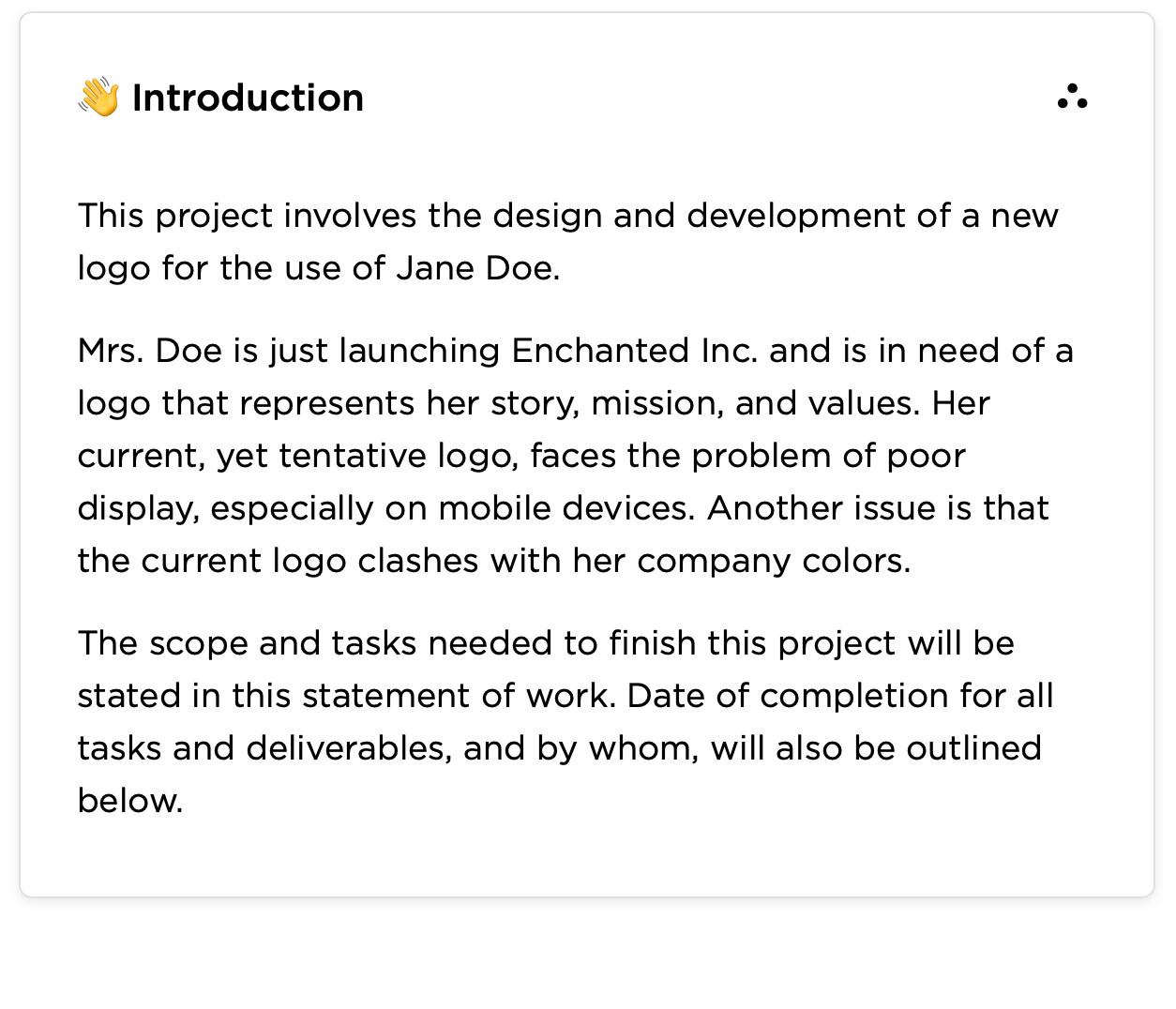How to Write a Wicked Statement of Work

Project managers, of all disciplines, are proud to say that they were perfectly capable of creating a statement of work, thank you very much. They were the last people you’d expect to be reading this strange and mysterious blog post, because they just don’t hold with such nonsense.
But even the most experienced have secrets to learn.
Today we are diving back into the book of project kick-offs, so you have all the tips, tricks, and spells to create a magical statement of work for your client.
Chapter 1: The Power of a SOW
A statement of work, commonly known as a SOW, is a document used during the initial phases of a project to narrate work requirements. Put more simply, a SOW defines every aspect of your project, from tasks and deliverables to timelines and terms of agreement. It is signed by both parties, yourself and your client, to ensure certain project goals and expectations are met.
If well-written, implementing a SOW to your kick-off period comes with countless benefits like:
- Defines project success
- Identifies project specifics so that all parties are up-to-date
- Manages stakeholder project expectations
- Helps the creative team focus on project goals
- Assists the project manager in creating updated roadmaps, schedules, budget allocations, etc.
- Keeps the project on track so that your team stays within agreed terms and conditions
🤔 So how do you write a statement of work?
Chapter 2: How to Brew a Terribly Wicked SOW
Like any project management document, every statement of work is unique. In this chapter, we are going to walk you through eight of the most important categories to add to your SOW. Let’s get going!
1. Introduction
Start off your statement of work with a short project description. Here you can talk about the purpose of the project, the issues you plan on addressing, the importance of the project in whole, and who is involved.
Your introduction should be short and to the point, maybe a paragraph or two. But don’t panic, you’ll have plenty of opportunities to expand on every point later in your statement of work.
Here’s an example:

💡Depending on your project, the language of your SOW can either be formal or casual. It’s up to you to gauge the appropriate tone of voice!
2. Purpose
In this section, define the vision of your project, namely your objectives. This section can touch on your goals and expectations.
Think of it like this: your introduction talked about the problems your client faces (what they need your help for), now state how this problem will be solved, AKA the goal of the project.

Again, don’t get hung up on the details yet. For now, you’re basically introducing the elements that will make up your scope of work.
3. Scope of Work
This section of your SOW is otherwise known as a scope of work. It involves determining and documenting specific goals and objectives, tasks, and deliverables. Additionally, a scope of work sets project boundaries, assigns responsibilities, and illustrates how work is completed and approved. It's arguably the most important part of your statement of work.
Your scope of work could look something like this:
- Task 1:
- Description:
- Assigned to:
- Deliverable:
- Task 2:
- Description:
- Assigned to:
- Deliverable:
- Task 3:
- Description:
- Assigned to:
- Deliverable:
Now it's time to be as detailed as possible. Clarity in your scope of work will save you time from conflicts and miscommunication stemmed from ambiguity and missing information. Since we know that a scope of work can be difficult to write, we have a whole separate blog post on it, and even a template to help you out.
4. Schedule
At this point, your client is probably wondering when all of this great work is to take place, and that’s exactly the content of section four. Here you add all your scheduling specificities, including:
- Project phases
- Task due dates
- Client review dates
- Deliverable dates
- Project completion dates
Don’t leave out any dates here, this schedule needs to be totally comprehensive. That way, you encourage transparency between your teammates and your client.
5. Terms
Time to get down to the nitty gritty. Your terms and conditions section is where you list out everything that you’ll need for a successful project, as well as any support you’ll need from your client. These are the conditions that need to be met for you to execute the project, so it’s critical that they are clear and comprehensive.
The contents of this section are highly dependent on your project. Meaning that it will change from project to project or client to client. These bulleted points are some examples to get you started.
- Testing resources
- Hardware or software restrictions
- Travel pay
- Post project support
6. Payment
While it’s sometimes awkward to talk about, setting your payment expectations and conditions is essential for a successful project. You might have talked about it before this stage, but now you should put it in writing.
Questions to consider:
- What’s included when working with you?
- Do you charge per hour or set a total price?
- Are the costs of your services set in stone from the beginning or do you give only an estimation?
- If needed, who is in charge of paying third parties?
- What methods of payment do you accept?
7. Success and Criteria
Another element to incorporate within your statement of work is a paragraph or two on project success and criteria. In other words, how do you and your client define a successful project?
It’s easy to say that success is when a project meets its objectives defined in the scope of work. But so much more goes into it, like budget and schedule for instance. In order to help your team and stakeholders make realistic expectations, determining what success looks like is a requisite of your statement of work.

8. Sign Off
Last but not least, the sign off. When your client has read through and agreed with your statement of work, they will provide their signature. This will of course make all parties accountable to the terms stimulated in the SOW.
Chapter 3: The Chamber of Best Practices
1. Get Specific
You probably got the point already, but your statement of work should be detailed and precise! That way, there’s no room for confusion or misunderstanding. Use language that’s clear and concise and limit ambiguous words with double meanings. If you set up your SOW like this, your project boundaries are sure to be evident!
2. Sign and Send
Make your statement of work known by all parties. Share it with everyone on the team so you, your colleagues, and your client understand their respective roles and responsibilities. With Collato, you can easily send your SOW with a URL-link. It’s a simple and secure way to share your work with anyone, anywhere.
In addition to sharing your work, it’s just as important to get your statement of work signed, to set everything in stone. You can also request a signature through Collato for fast and effortless collaboration. And the best part, your client doesn’t need to create an account to provide a signature. Easy peesy!
3. Use Visuals
Incorporating color-coded timelines, milestones, and calendars can be a great way to get certain dates and project phases stuck in your head. Or you can add graphs, charts, and photos to really make your statement of work memorable. Don’t worry, you can make both a beautiful and professional SOW.
With Collato, you can add all these features to your statement of work, just with a simple few clicks. Check out how you can create your own on our main page!
The Final Chapter
In the wizzarding world of design, long and detailed documents like a statement of work might seem like a total bore. But we promise that it’s worth your time and effort!
But if you’re too busy practicing spells, fighting black magic, or just have too much on your plate, let Collato help. We have all the spells and potions you need to create your own SOW (we even have a template to help you out with the scope of work!). Click here to learn more!
🍦 Related topics you may be interested in:
1. Never stress over document reviews again
